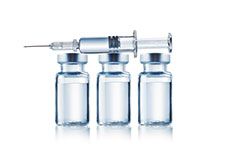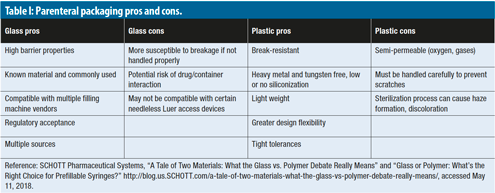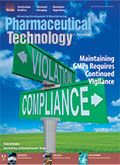Selecting Primary Packaging for Parenterals
Traditional glass and polymeric materials compete for market share in primary packaging for parenteral drug products.
JOOH/SHUTTERSTOCK.COM

Despite the proliferation of new drug delivery systems for parenteral products, glass vials remain the most widely used primary containers worldwide. This trend is expected to continue for several years, with global demand for glass vials projected to rise to $5.7 billion in 2024 (1).
In fact, borosilicate glass has been the primary packaging choice for parenteral products since its development more than 100 years ago due to its excellent barrier properties, chemical resistance, regulatory acceptance, and broad range of applications served.
But glass is not the only choice, especially for sensitive biotech products, and polymeric materials have captured market share in recent years. Polymeric materials offer light weight, shatter resistance, greater formability, tighter tolerances, strong barrier, and chemical compatibility. As a result, plastic packaging is gaining ground with global demand for plastic parenteral vials forecast to grow 7.7% per year to more than $1.6 billion(13.1 billion units) in 2021 (2).
One popular polymeric option, cyclic olefin copolymer (COC), combines formability, break resistance, and light weight with a glass-like transparency. Other polymers such as cyclo-olefin polymer (COP) and polyethylene naphthalate (PEN) offer similar attributes.
“The physical stability as well as the diverse design options make COC an attractive alternative for some drugs,” explains Tom Van Ginneken, global product manager SCHOTT TopPac at SCHOTT Pharmaceutical Systems, a supplier of glass and plastic packaging for parenteral products. Anna Malori, business development manager at Bormioli Pharma, a producer of pharmaceutical primary packaging both in glass and plastic, agrees and predicts, “Some fields of application for COC will be highly sensitive drugs, biotech drugs and vaccines, and high-value drugs such as oncology treatments.”
Glass or plastic?
With glass and polymers offering advantages and limitations in different scenarios, many factors must be considered to determine the better choice. Some pros and cons are listed in Table I. Commercializing new primary packaging for parenteral products tends to be time-consuming due to the complex regulatory approval procedures that must be followed to adopt a new packaging material. “The regulatory approval process can take years, and that is why each single change in the glass vial configuration may be seen as an obstacle toward the final drug product approval,” explains Malori.
As a result, many producers of glass packaging for parenteral products are leaving glass chemistry unchanged, but they are fine-tuning processes and quality control practices and increasing inspection capabilities to ensure shipment of flawless finished containers.
Malori says: “Each packaging choice should be strictly related to the specific needs and characteristics of the formulation that will be contained inside.” Working in close collaboration, the packaging supplier and drug maker identify the best packaging material and container-closure system for the formulation. Once that decision is finalized, suppliers provide support during the validation process.
Ginneken details the holistic approach: “We consider what we call the three Ps-product, process, and patient. For example, we examine specific requirements for the drug. Does it need a particularly inert packaging? We also look at the process requirements to consider how the product will be integrated into existing manufacturing lines or how to create a low-waste filling process, among others. Lastly, we focus on the patient as we aim to continuously meet the patient’s comfort and needs. Therefore, we study if drug delivery in a home setting is required. If so, the primary packaging must be easy to handle for the patient and work with self-administration devices.”

Expanding applications
The need for stability and design flexibility have increased market share for polymeric materials, especially in the prefilled syringe segments. Applications include a variety of therapeutic areas within clinical settings, home care, or hospital-care environment.
“Benefits such as break resistance and reduced risk of syringe clogging make prefillable polymer syringes ideal for emergency drugs and diluents,” says Ginneken. “Moreover,” he adds, “polymer syringes are also suitable for highly viscous drugs, such as hyaluronic acid, which is used in the cosmetic field. In addition, large-format polymer syringes of 10, 20, or 50 mL are especially suited for infusion therapy in conjunction with syringe pumps, which allow continuous administration of a drug, such as anesthetics or cardiovascular medications, for a longer period of time. To ensure a seamless integration of the syringe and pump, packaging suppliers and device manufacturers must work closely together.”
The more complex molecular structure of biotech drugs requires packaging with properties that ensure stability. SCHOTT offers polymer as well as glass containers for the pharmaceutical market. Polymeric packaging can offer a lower extractables and leachables profile as well as tighter dimensional tolerances. As a result, polymeric primary packaging, such as the SCHOTT TopPac SD COC syringe, is gaining ground for highly sensitive products.
Optimized glass containers, however, also address the need for stability. A new option for glass containers, Valor Glass from Corning, is a coated aluminosilicate glass that became commercially available in 2017. Eliminating boron from the formula and altering the ratios of other ingredients results in glass with a high degree of chemical durability and surface homogeneity and virtually eliminates delamination problems. An ion-exchange process helps minimize breakage, cracks, and particulate contamination, while the coating lowers coefficient of friction and eliminates cosmetic flaws. Despite the difference in chemistry, Valor Glass meets the current United States Pharmacopeia (USP) Type I hydrolytic criteria and has low extractable concentrations (3).
Another optimized glass option, Gx Elite Type I borosilicate glass vials from Gerresheimer, relies on proprietary technology to produce an extremely durable, delamination-resistant vial that is free of cosmetic defects. Compression and side-wall impact tests show the Gx Elite vials are substantially stronger than standard Type I glass vials (4).
Gerresheimer also supplies polymeric vials. Its Gx MultiShell vial features a multilayer COP and nylon structure, which offers clarity, shatter resistance, and barrier protection. Sizes include 2-, 5-, 10-, 15-, 50-, and 100-mL vials, which can be supplied ready-to-use (including validated gamma sterilization). Gerresheimer also offers monolayer COP packaging for parenterals (5).
A press-blow process gives Clareo Type 2 glass vials a more uniform wall distribution, flatter bottoms, and enhanced strength. “The vials perform better with less breakage and uniform heat transfer,” reports Kevin McClean, quality and technical manager, Americas for SGD Pharma Packaging. The Type 2 glass containers cost less than Type I and are an acceptable alternative to regulatory authorities for some molecules. Clareo vials currently may be ordered in 20-, 50-, and 100-mL sizes (6).
Syringes also feature optimized glass. To maximize the quality of Ompi Nexa syringes from Stevanato Group, the production process eliminates glass-to-glass contact and minimizes glass-to-metal contact. Automated inspection checks each container. Options include a 1-mL long design and a 2.25-mL design with staked needle (7).
Whether glass or plastic, the highest levels of activity are being observed in the development of cartridges for pen and infusion pump systems and a transition from vials to prefilled syringes. In addition, “There’s a lot of activity in auto-injectors for insulin,” says Dave Dugan, account manager for Stevenato Group’s Ompi of America.
One of the major forces driving interest in auto-injectors is the growth in home care. Self-administration “lessens the burden on the healthcare system,” says Uzzo Calderaro, business development manager at Duoject Medical Systems. “When a patient can stay at home, there’s cost savings and a better quality of life for the patient,” he explained. Well-designed auto injectors also reduce the chance of sharps injuries, prevent loss of product, and deliver accurate doses.
With auto-injectors, easy, consistent operation is essential, because the devices are intended for patient use. Uniform silicone levels are needed to ensure consistent movement of the plunger and help keep injection duration at no more than 10 seconds. These features do not come without challenges. “When injection time needs to be reduced, the drug needs to be concentrated, which increases its viscosity, necessitating more pressure on the syringe and increasing the chances of breakage,” says Dr. Nicolas Eon, SCHOTT’s global product manager, syriQ.
Made of highly inert FIOLAX borosilicate glass, the recently launched syriQ BioPure staked-needle syringes offer low tungsten and adhesive residuals for a superior extractables and leachables profile, plus accurate dimensions for optimal device compatibility. To maximize mechanical resistance and minimize the chance of breakage, the syringes are produced under strict cosmetic defect specifications in a process that eliminates glass-to-glass contact. A multi-camera quality control system provides 100% inspection of the complex shape from tip to flange. To accelerate speed to market, SCHOTT offers more than 40 validated configurations combining different flange designs, 27-g or 29-g needles, and elastomer components along with full documentation. “The availability of full documentation reduces the risk profile for the drug maker and ensures the syringe and device work together,” notes Eon.
Some auto-injectors, especially those integrated into wearable devices, rely on cartridges. “Cartridges occupy less space and cost less than prefilled syringes,” explains Duoject’s Calderaro. Duoject has developed a multi-dose auto injector with a diluent-filled cartridge. The modular, integrated Penprep Evo system simplifies reconstitution and ensures dose accuracy via patented vacuum transfer technology, which also minimizes drug hold-up in the vial and air transfer back to the cartridge. Configurations include 13- or 20-mm drug vials with various diluent fill volumes (8).
Another recent auto-injector development, the SelfDose patient-controlled injector from West Pharmaceutical Services, departs from the traditional spring-loaded design and is larger than most pen systems. “The SelfDose injector restores control to the user, particularly for the arthritic population who may find standard injectors difficult to use,” reports Carl Dabruzzi, director, Self-Injection Systems at West Pharmaceutical Services. The golf-ball size top of the larger-than-usual injector features a 1-mL long syringe. To use, the patient simply removes the cover and pushes down to dispense. Injection speed is user controlled and may even be paused. A visual indicator ensures proper administration. Needle depth can be customized to optimize drug absorption, and the needle is not visible before or after injection (9).
For wearable devices, West Pharmaceutical Services offers its SmartDose drug delivery platform. “We’re seeing a lot of IV [intravenous] products being developed for subcutaneous administration via wearable devices,” explains Dabruzzi. Driving forces for the transition include cost containment and patient convenience. A wearable device, he notes, reduces the need for trips to an infusion clinic. “With one or more visits per week at $300 to $1200 [260–1030 Euros] per visit, costs for infusions can easily add up to thousands of [US] dollars per year, plus the cost of the drug product. Instead, the wearable device is applied and activated, and audible and visual indicators guide the patient through the administration process.”
The SmartDose drug delivery system is based on a user-loaded, custom COP cartridge with septum/cap and FluroTec piston. Pre-programmed delivery times and duration can give the patient a more comfortable injection experience, particularly when delivering high-volume or high-viscosity drugs (10). Dabruzzi adds, “A patient who experiences pain or feels intimidated about self-injection is less likely to be compliant. So increased patient comfort is likely to improve patient compliance, which leads to better outcomes.”
References
1. Freedonia, “World Pharmaceutical Packaging Industry Study #3269,” July 2015, p. 73-75.
2. Freedonia, “World Pharmaceutical Packaging Industry Study #3591,” January 2018, p. 66-67.
3. H. Forcinio, Pharm. Tech. Europe 29 (9) 18-19 (2017).
4. Gerresheimer, “Gx Elite Glass Vials Setting New Standards Regarding Quality Requirements,” www.gerresheimer.com/en/services/innovations/elite-glass-vials.html, accessed May 24, 2018.
5. Gerresheimer, “Gerresheimer to Unveil Innovative Vials Made from Glass and Plastic at the PDA in Orlando,” Press Release, March 15, 2018.
6. SGD Pharma Packaging, “SGD Pharma Introduces Its New Clareo Range,” www.sgd-pharma.com/company-news/sgd-pharma-introduces-its-new-clareo-range, accessed May 24, 2018.
7. Stevenato Group, “Prefillable Syringes,” https://pharma.stevanatogroup.com/glass-primary-packaging/products-platforms/prefillable-syringes/#nexa-syringes, accessed May 24, 2018.
8. Duoject Medical Systems, “Penprep EVO,” http://duoject.com/realisations/penprepevo/, accessed May 24, 2018.
9. West Pharmaceutical Services, “SelfDose Patient-Controlled Injector,” www.westpharma.com/products/self-injection-platforms/selfdose, accessed May 24, 2018.
10. West Pharmaceutical Services, “SmartDose Gen. I 3.5 mL Drug Delivery Platform,” www.westpharma.com/en/products/self-injection-platforms/smartdose/smartdose-gen-I, accessed, May 24, 2018.
Article Details
Pharmaceutical Technology
Vol. 42, No. 7
June 2018
Pages: 46–50
Citation
When referring to this article, please cite it as H. Forcinio, "Selecting Primary Packaging for Parenterals," Pharmaceutical Technology 42 (7) 2018.
About the Author
Hallie Forcinio is Pharmaceutical Technology’s Packaging editor, editorhal@cs.com.

Pharmaceutical Tariffs Are Imminent: How Industry is Bracing for Impact
April 16th 2025On April 14, 2025, the Trump Administration launched a national security-driven investigation into pharmaceuticals, a move that will likely result in tariffs being placed on pharmaceutical drugs, ingredients, and other components that are imported from outside of the United States.
Drug Solutions Podcast: A Closer Look at mRNA in Oncology and Vaccines
April 30th 2024In this episode fo the Drug Solutions Podcast, etherna’s vice-president of Technology and Innovation, Stefaan De Koker, discusses the merits and challenges of using mRNA as the foundation for therapeutics in oncology as well as for vaccines.